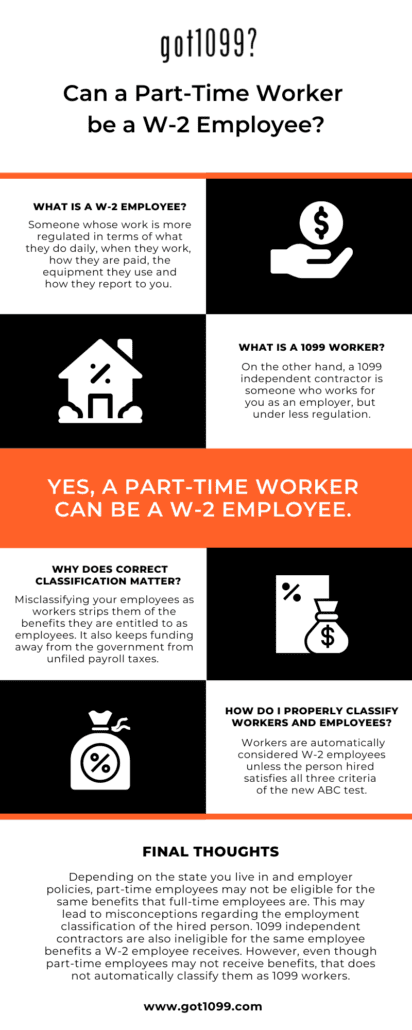Depending on the state you live in, and the employer policies, part-time workers may not be eligible for the same benefits as full-time employees. While the benefits they must be offered differ based on their hours, that difference does not relate to their classification as a 1099 vs a W-2. Misconceptions persist regarding employment classification of part-time vs full-time vs contract or project-based workers. Following is an explanation and clarification of why a part-time worker can be a w-2 employee.
What is a 1099 worker vs. a W-2 employee?
A W-2 employee
A W-2 employee is someone whose work is controlled by the employer in terms of what they do, when they work, how they are paid, the equipment they use (provided by the employer), and how they report. W-2 workers most often only work for one employer and have a set schedule to which they are expected to adhere.
Full-time W-2 employees receive (or are offered) benefits.
Part-time W-2 employees can be offered benefits at the discretion of the employer.
All W-2 employees’ engagements are ongoing, whereas many 1099 contractor engagements have an end date or a project completion as the end of the relationship.
All W-2 employees have taxes withheld from payroll and are paid on a set schedule through either payroll or payroll software.
A 1099 contractor
A 1099 independent contractor is someone who has their own business and provides services to another business on a per-project basis that is invoiced for payment.
All legitimate 1099 contract workers have their own business entity, their own license, their own insurance and invoice the hiring company for payment.
A 1099 service provider sets their own hours and negotiated a Scope of Work with a hiring company. They pay their own taxes and must give the hirer a W-9 at year-end when they receive their 1099 form. Most 1099 contractors work for multiple different hiring entities simultaneously.
How to tell the difference between a 1099 and a W-2
One element of the ABC test to use is the right of control. This benchmark will help make the distinction between a W-2 employee and 1099 independent contractor by asking these questions:
- Behavioral Control: Are you in charge of the manner in which workers perform their duty?
- Financial Control: Do you pay regular wages and have the ability to fire the employee?
- Relationship to business: Is the employee an essential part of helping your business run?
If you answer that you are in charge of the way the worker performs their job, pay them regular wages (like a bi-weekly paycheck), and the worker is an essential part of keeping your business running, then they must be classified as a W-2 employee.
If you are not in charge of the way the worker performs their task, if they perform work outside of your service offering, if they negotiated their rate of pay and submitted a scope of work and they are not an integral part of keeping your business open each day, they can be classified as a 1099 independent contractor.
Can a part-time worker be a 1099 worker?
While a part-time employee can be classified as a W-2, the same can be said for a 1099 worker. Their proper classification boils down to what they do for your business, and how much control you have over their work.
A part-time W-2 worker may work the same hours as a 1099 worker, but they will have different behavioral, financial, and relational control with the employer. The number of hours worked has no effect on classification itself.
For example, a plumbing company may hire a part-time plumber to work Monday, Tuesday, and Wednesday resulting in 24 hours of work a week. This plumber is paid every other week, has taxes deducted, receives partial benefits, reports when asked, uses the tools provided by the company, and performs specific job functions that help the company run day-to-day operations. This plumber is a W-2 working part-time.
That same plumbing company may hire an independent contractor part-time to work on specialized projects outside the expertise of the company’s core offering, for example, marine plumbing jobs or sewer hydro jetting. This contracted plumber would work on-call, they would not be on payroll, but would invoice the plumbing company for services performed, and they would bring their own tools to the job. If the contracted plumber takes 24 hours to complete the project, the time it takes to complete has no effect on the classification of the worker. This plumber would be a 1099 contractor.
Why Does Correct Classification Matter?
Correctly classifying between W-2 and 1099 workers is important because misclassifying your employees as 1099 workers strips them of the benefits they are entitled to as employees. It also reduces the amount the hiring company pays to the government in the form of payroll taxes. In a misclassification lawsuit brought by the DOL against a shipping company called Dynamex Operations, the California Divison of Labor found that the misclassifications identified cost the state of California $7 billion for each year that Dynamex misclassified their employees.
In order to protect workers’ and ensure proper taxes are paid to the government, the Employment Development Department (EDD) conducts frequent audits of businesses they flag as potentially misclassifying employees.
Four EDD audit triggers that can open your business up for an audit include:
- Independent contractor filing for unemployment
- An employee filing a complaint to EDD
- Filing taxes late
- Random site sweeps
If the agency uncovers misclassifications, your business will be subject to fines and penalties to make up for unpaid payroll taxes.
How Do I Properly Classify Workers and Employees?
Before filing workers as W-2 employees or 1099 independent contractors, remember the rules and regulations that help guide businesses to correctly classify their workers. Before, the system for classifying workers was ambiguous and guided by the loose regulations of the 13 factor Borello test. After January 1st, 2020, Assembly Bill 5 (AB-5) went into effect, changing the previous classification system.
AB-5 put into place stricter regulations for classifying an independent contractor as such. The rules are clearer and have regulated boundaries through the ABC test for employers to stay within.
According to the ABC test, workers are automatically considered W-2 employees unless the person hired satisfies all three of the following criteria:
- “The worker is free from the control and direction of the hiring entity in connection with the performance of the work, both under the contract for the performance of the work and in fact;
- The worker performs work that is outside the usual course of the hiring entity’s business; and
- The worker is customarily engaged in an independently established trade, occupation, or business of the same nature as that involved in the work performed.”
For more information about how to properly hire a 1099 independent contractor, read our article here. We explain what you need to verify to correctly classify your worker, what to do if your worker is missing important elements to help verify them as a worker, and how a got1099 report gives you the peace of mind that your workers are properly classified.

LOCATION
La Jolla, CA 92037
o: (888) got-1099 (468-1099)
e: contact@got1099.com
copyright got1099®
copyright got1099?®
copyright Start1099®
GET AB-5 And CASLB Updates in your inbox
IMPORTANT INFO
Disclaimer
got1099 is a business reporting company providing business analysis reports to companies re: their 1099 independent contractors We do not provide legal advice. Consult with your attorney relating to any legal issues.


